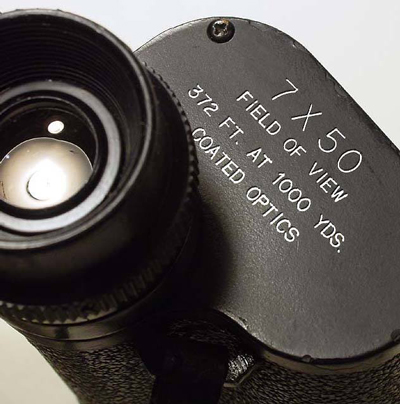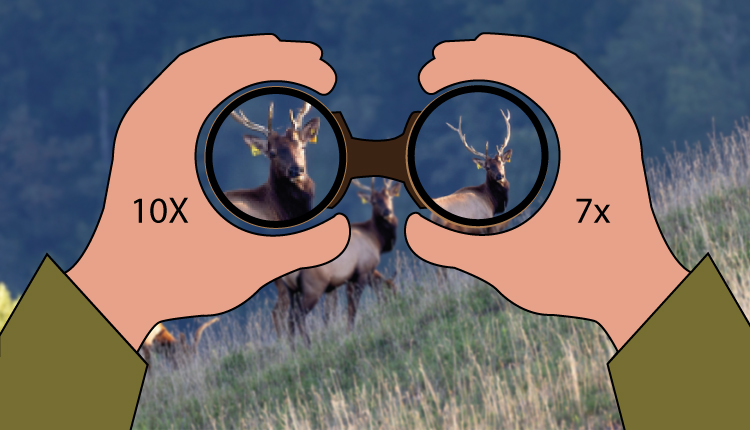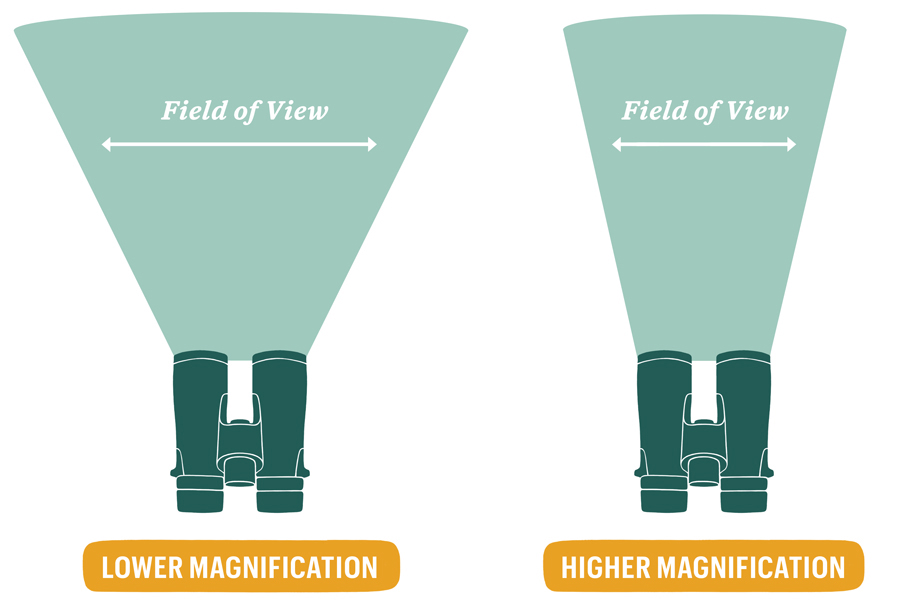So you have decided to buy your first pair of hunting binoculars, which is exciting. But before you break open the piggy bank, there are a few things you need to know. The key among them is what do the numbers on binoculars mean.
Binoculars have several numbers printed on them. These numbers are meant to give you a wide range of information about the binocular you are about to buy.
That being said, in this article, we will be discussing the Meaning of Binocular Numbers.
What Do Binocular Numbers Mean?

What Does Magnification Number Mean on Binoculars
When you look at a binocular, you will notice a number consisting of two figures. For example, 8×40 or 10×50. So what exactly does this number mean, and what does it say about the binocular.

This number is representative of a binoculars’ two most important features, magnification and objective lens.
The first number refers to a binoculars’ magnification level. As such, a 10x binocular can make an object appear ten times closer than it is. The higher the number, the nearer objects will appear.
That means a 12x binocular will make objects appear closer than a 10x one. Of worth noting is that a high magnification of 12x and over makes it difficult to maintain a steady image. The solution is stabilizing the binocular on something stable, such as a tripod.
So how far can you see with 10×50 binoculars? A 10x magnification will be sufficient for observing objects about 2KM away. However, for spotting things 3km or more away, you will need a higher magnification of about 16x or 20x. For that, you can buy zoom binoculars which will allow you to play with the adjustable magnification range.
What is Objective Diameter In Binoculars
The second number that follows the magnification denotes the binoculars’ objective lens size. The objective lens is located on the other side of the eyepiece you use to look through the binocular.
Now you may ask what does binoculars 10×50 mean? Therefore, a 10×50 binocular has an objective lens with a 50mm diameter. The wider that lens, the heavier the binocular. Also, a wider objective lens means more light passing through it. As such, a 10×50 binocular will be better for nighttime viewing than a 7×35 one.
Also, a larger objective lens means more shakiness in the image. This is because a wide objective lens increases the weight of the entire binoculars.
What is the angle of view In Binoculars?
The next two numbers you are likely to notice printed on binoculars are for the angle of view and field of view. The binocular numbers definition for these two numbers is mostly the same. The angle of view is usually indicated in degrees.
These two numbers refer to the amount of horizontal area that is visible through binoculars. For example, most of the best binoculars under 200 will have an angle of view of 6 degrees, while some will have a high number, such as 72 degrees indicated.


However, this is usually the actual angle of view and is obtained by multiplying the magnification with the angle of view. For example, if a binocular has a 10x magnification and an angle of view of 7.2 will have an actual angle of view of 72 degrees.
On the other hand, the field of view is indicated in feet per 1000 yards or meters per 1000 yards. A higher number means you have a wider horizontal view. A field of view of 300 to 375 is sufficient for most people.
It is possible to convert the angle of view to the field of view. This is done by multiplying the angle of view by 52.5. That means an angle of view of 7.2 degrees translates to a 378 field of view.
Linear Field of view
The field of view is the same as the angle of view. But Field of view is not expressed as Degrees rather they are expressed as feet per 1000 yards or feet per 1000 meters. The higher the field of view the wider you can see the surroundings.
What is important to note is that the field of view is affected by increased magnification. Therefore, higher magnification will result in a narrower field of view. For hunting 350 to 400 Fov is quite enough.

This raises the question of what does 10×50 means in binoculars, especially in relation to the field of view. While the field of view is affected by magnification, it is usually in relation to the objective lens size. Therefore a 7×35 binocular will have a wider field of view than a 10×50 one.
There is a magic number to convert the angle field of view to linear field of view and that is 52.5. So if you get the only angular field of view and want to know the what is linear field of view of that certain bino just multiply the 52.5 with the angular field of view.
Let’s say your bino’s angle of view is 8 degrees in that case the field of view of that bino is 52.5×8 = 420 ft per 1000 yards.
Exit pupil
The exit pupil number is another you are likely to find on a binocular. This one is usually measured in millimeters, e.g., 3.1 mm. You need to hold a binocular about 8 inches away from your eye to understand the exit pupil.
You will notice two dots at the center of the eyepiece. This is where the light from the lenses hits your eyes to allow you to see an object.
The best Binoculars under 100 will have an exit pupil of 4 inches or more. The exit pupil number is obtained by dividing the objective lens size and magnification. For example, a 10×50 binocular will have an exit pupil of 5mm.
Eye relief
This particular number is essential to glass wearers. The eye relief is how far you can be from the binocular’s eyepiece and still see the binoculars’ whole field of view. Similar to the exit pupil number, this one is also indicated in millimeters.
Good Night vision binoculars will most likely have an eye relief of 8 to 10mm. This is a good enough eye relief for glass wearers. Essentially, the higher the eye relief, the better the binocular.
Relative Brightness Index:
Relative Brightness Index indicates How bright a binocular can produce details as seen from a given distance. If you own a 10×25 size binocular, the relative brightness index number is 6.25. In contrast, the RBI of 8X42 binoculars is 27.6 and 8×32 binocular RBI is 16. When you divide the objective lens by magnification number, you will get the RBI (42÷8) = 5.25, and squaring 5.25²=27.6. Another example of RBI of 10×42 binoculars is 17.64, and 8×50 binocular RBI is 39.06. From there, we can conclude that the size of the magnification lens is correlated with the RBI.
Twilight Factor:
The Twilight Factor measures how visible objects become in low light. A binocular with a greater twilight factor will allow you to see more details in low light conditions. This can be calculated by multiplying the magnification and objective lens numbers and then square root them to get the Twilight Factor. For example, the twilight factor of 10×42 is √(10×42) =√420 = 20.49. At the same time, the twilight factor of 8×42 is 18.33.
Waterproofing Number:
Some binoculars are listed as waterproof up to 100 millibars or even more. But what does it mean with the millibars? Well, if we take the 100 millibars as a reference, we can say it can be submerged to water down to only 3.35ft.
Close focus
Binoculars are designed for seeing far-off objects. Therefore, they do not do well when it comes to close-distance objects. However, suppose you want binoculars for bird watching. In that case, you will probably want to get a clear view of relatively close birds.
This is where close focus comes into play. The narrow focus is the minimum distance a binocular can focus on. So, for example, a close focus of 13 feet means you will be able to see objects that are at least 13 feet away from you.
For some people, this number is not necessary, but for others, it is. In this regard, Rangefinder binoculars designed for hunting have a close focus of 15 feet. However, some birdwatching models have a close focus of up to 6 feet.
Some quick Tips To Follow Before Buying a new pair of Bino
- Binoculars with a high objective lens diameter transmit a large amount of light.
- Larger magnification creates shakiness in the image as well as provides a small field of view.
- Larger objective lenses increase the overall weight of the binoculars.
- Look for an eye relief of at least 15mm if you wear glasses, to ensure that your eyes are not resting against the lenses.
- An exit pupil size of 4 mm is recommended for night viewing, to allow more light into the eye and reduce eyestrain.
- When using binoculars for close viewing, be sure to focus close by so that details are clearly visible.
Conclusion
In this article, we have discussed the binocular numbers, meaning of the most important figures. These are the numbers that will help you know what a binocular is good for. For instance, a binocular with high magnification is excellent for astronomy.
In contrastingly a binocular with a close focus is ideal for birdwatching. On the other hand, a wide field of view is essential for hunting and birdwatching purposes.

About The Author:
Lake Streeter, A Gun enthusiast, and loves to hunt in the middle of the wood. Always check the latest hunting gears out in the market and try to share his honest opinion with the audience in Hunting Nook.

4 thoughts on “What Do The Numbers On Binoculars Mean – Explained!”
Thanks! Very helpful.
You are welcome. 🙂
what does 60×60 mean?
60 x 60 means that the binoculars have a magnification of 60 times and an objective lens diameter of 60 millimeters. This is useful for seeing details at long distances and also when you want to get closer up to an object such as birds in flight or mountains in the distance. This magnification is equivalent to a telescope with its highest power.